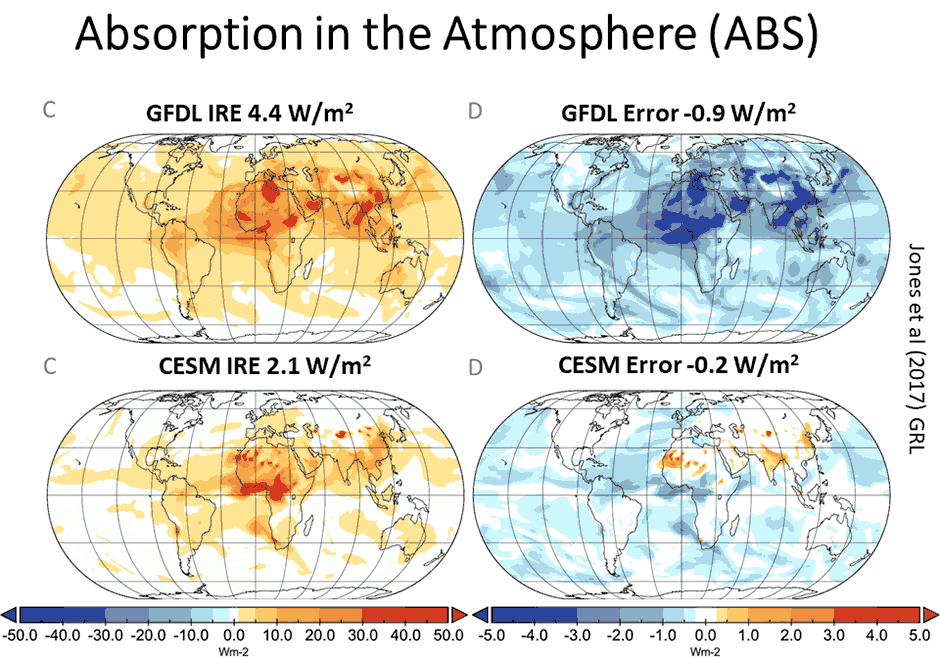December 20th, 2017
Key Findings
- To address a recognized, persistent uncertainty in aerosol radiative forcing, the authors performed a systematic evaluation of the impact of radiative parameterization errors across the diversity of aerosol distributions resulting from the same experiment in global climate models.
- The change in direct, unadjusted radiative flux that would result from instantaneously removing all aerosol from the atmosphere was evaluated for two different models, as a proof of concept.
- Results show that the models’ aerosol radiative bias is of the same magnitude as the persistent range seen in IPCC models cited (~1 W/m2), and also varies spatially and with intrinsic aerosol optical properties.
- This approach to evaluating radiative parameterization error can be used to address errors in climate models, resulting in more accurate simulations of the climate’s response to radiative forcing.
A.L. Jones, D.R. Feldman, S. Freidenreich, D. Paynter, V. Ramaswamy, W.D. Collins, R. Pincus. Geophysical Research Letters. DOI: 10.1002/2017GL075933
Aerosol radiative forcing and its uncertainty are seen as major challenges that climate models face in reproducing observed temperature records. Climate models, such as those reporting results for the Fourth and Fifth Assessment Reports of the Intergovernmental Panel on Climate Change, exhibit a persistently large range of aerosol radiative forcing, both natural and anthropogenic. For this research, the authors carried out a systematic evaluation of the impact of radiative errors on simulated aerosol radiative effect across the diversity of aerosol distributions resulting from the same experiment, to address a persistent ambiguity in climate sensitivity.
Given the divergence of spatial, temporal, and optical properties of atmospheric aerosols, their actual contribution to forcing is particularly challenging to quantify. The large range of aerosol radiative forcing implies that diagnostics of climate sensitivity over the 1850–2005 historical period are hampered by an imprecise understanding of forcing agents. It is not known whether the ~1°C of warming seen over that period might be due to large negative aerosol forcing in a high-sensitivity climate or small aerosol forcing in a low-sensitivity climate.
The authors evaluated the aerosol instantaneous radiative effect (IRE) – defined as the change in direct, unadjusted radiative flux that would result from instantaneously removing all aerosol (both natural and anthropogenic) from the atmosphere. This was completed for two different models (GFDL’s AM4 and NCAR’s Community Earth System Model 1.2.2), as a proof of concept. The authors helped to quantify persistent sources of biases in the IRE and hope to provide modeling centers with the detailed information necessary to uncover sources of error.
Instead of prescribing atmospheric conditions and aerosols, as in prior intercomparisons, native snapshots of the atmospheric state and aerosol optical properties from the participating models are used as inputs to an accurate radiation solver to uncover model-relevant biases. These diagnostic results show that the models’ aerosol IRE bias is of the same magnitude as the persistent range seen in IPCC models, and also varies spatially and with intrinsic aerosol optical properties. The findings underscore the significance of native model error analysis and its utility to diagnose global biases.
The authors ran a line-by-line model coupled to an absorbing and scattering multi-stream radiative transfer solver at every grid point for each climate model on specified dates. The individual model benchmark calculations, when compared to that model’s native calculations, elucidated that model’s radiative parameterization error. This enabled visualization of error both spatially and as a function of aerosol optical properties, allowing for robust hypothesis formulation of error sources.
This new, rigorous approach to evaluating radiative parameterization error can be used to address errors in climate models, resulting in more accurate simulations of the climate’s response to radiative forcing.



